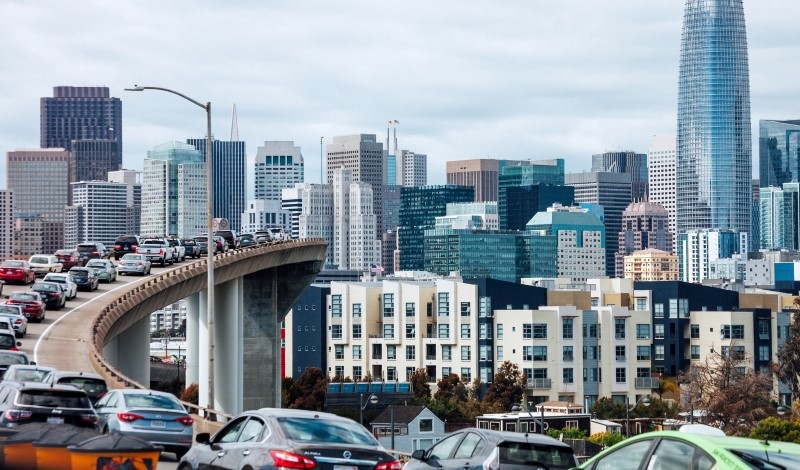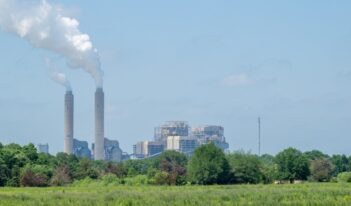
Scholars recommend policies to address the harms of excessive noise.
Last month, the nonprofit Quiet Communities argued in a lawsuit that the U.S. Environmental Protection Agency (EPA) “has made no progress in protecting the American people from the many harmful effects of noise pollution.”
Today, that pollution—from blaring horns, roaring aircraft engines, and other sources of unwanted sound—damages public health and inflicts a disparate level of harm on marginalized communities. Regular exposure to excessive noise has been shown to contribute to conditions such as heart disease, psychological disorders, and premature death. Scholars have also found that exposure to excessive environmental noise may impair cognition and impact children’s ability to learn.
Communities of color and low-income neighborhoods are more likely to be located near sources of noise pollution such as highways. Yet at the same time, according to some scholars, various local laws related to sound are at times weaponized against communities of color as a means of social control.
Excessive noise also poses dangers to wildlife. For example, increasing levels of anthropogenic underwater noise have detrimental effects on marine animals that rely on sound to survive, such as whales.
With its passage of the Noise Control Act of 1972, Congress gave EPA the responsibility to set regulatory standards for noise pollution. Congress charged the agency with issuing noise abatement criteria, setting noise emissions standards for products, and disseminating information to the public.
In the 1970s, EPA carried out this mandate through the Office of Noise Abatement and Control. Under President Reagan, however, this office was defunded. EPA now asserts that the “primary responsibility” for noise regulation exists at the state and local levels.
Around the globe, some regulatory authorities have made noise pollution a top priority. The European Union, for example, aims to reduce by 30 percent the number of people chronically disturbed by transportation noise by the year 2030.
In this week’s Saturday Seminar, scholars and other experts discuss possible regulatory solutions to noise pollution.
- The American Public Health Association (APHA) called for national standards on noise pollution in a 2021 policy statement. The APHA advises Congress to implement a well-funded federal noise control program to continue EPA’s work under the Noise Control Act. It warns, however, that because international standards have progressed in the 40 years since the act’s passage, the United States should seek guidance from international agencies such as the World Health Organization to set updated, evidence-based standards. The APHA also recommends that the United States model its federal noise pollution program on the European Union’s Environmental Noise Directive, which requires member states to monitor, report on, and address issues of noise exposure using a uniform set of indicators.
- In a report for the Urban Institute, Gabe Samuels and Yonah Freemark propose that zoning decisions can limit exposure to noise and air pollution from highways and have a positive impact on life expectancy, quality of life, and social equity. Samuels and Freemark discovered that permits in Louisville, Kentucky, for multi-family units were more than twice as likely to be located within about 500 feet of an arterial road as those for single-family units. These findings align with national data indicating that individuals experiencing poverty are disproportionately likely to live near highways, leading to increased exposure to noise and air pollution. To protect residents and combat inequity, Samuels and Freemark recommend that local governments consider highway proximity when evaluating residential housing projects for funding. They also urge governments to require health impact assessments for roadway expansions and invest in pedestrian-friendly infrastructure and public transportation.
- In a report following recommendations on noise mitigation to the Federal Aviation Administration (FAA), Heather Krause from the U.S. Government Accountability Office argues that the FAA has more work to do to address the impacts of aircraft noise on communities. Krause suggests that to better address public concerns, the FAA should implement supplemental noise metrics to monitor noise from aircraft with more precision. Furthermore, Krause explains that although the FAA has taken steps to improve public outreach, it should simplify information about planned changes, such as increases in flight frequency, to avoid causing frustration. Finally, Krause observes that the FAA should provide clearer guidance on how and to what extent communities can seek technical assistance from the FAA when those communities seek to propose new flight paths.
- In an article published in Environmental Science and Pollution Research, Yalcin Yildrim, Golnaz Keshavarzi, and Mahyar Arefi analyze noise complaints across five major U.S. cities during the COVID-19 pandemic. During lockdowns, these cities observed a rise in noise complaints that correlated with the compactness of the city. Yildrim, Keshavarzi, and Arefi contend that urban designers should prepare for similar situations in the future by prioritizing noise mitigation in compact developments. Yildrim, Keshavarzi, and Arefi acknowledge the benefits of city compactness but suggest that the relationship between dense environments and noise deserves more attention from urban and environmental planners.
- Unlike other threats to health, environmental noise has often been dismissed as a mere fact of life, according to Eoin King of the University of Galway, writing in Environment: Science and Policy for Sustainable Development. King notes that mounting evidence links noise to adverse health effects, and he argues that this “forgotten pollutant” is now recognized by many scholars as a public health issue that needs to be prioritized. The United Nations, however, neglects noise pollution as a priority in its Sustainable Development Goals, King explains. King contends that because the issue of noise pollution intersects with each of the U.N.’s existing sustainability goals, prioritization of noise regulation would contribute to the success of sustainable development overall.
- Noise pollution is no less threatening than air or water contamination, argues Joanna Jablońska of Wroclaw University of Science and Technology in an article in Polish Political Science Review. Jablońska urges that it is possible to balance a city’s development needs with the need to create quiet spaces. As evidence, she offers a case study of noise policies in Tokyo, a city made up of over 13 million residents yet nicknamed a “city of silence.” Jablońska credits the city’s quietness in part to strict national noise regulations, which, for example, limit daytime noise from certain factories to 45 to 50 decibels. At the local level, Jablońska points to several factors, including Tokyo’s investment in electric-powered public transportation, such as subway lines, streetcars, and private rails; its devotion of large swathes of the city’s surface to pedestrian zones; the installation of walled green spaces and parks; and strategic zoning of noisy entertainment districts. Jablońska concludes that, with careful urban design and regulation, control over noise even in a large city is achievable.
The Saturday Seminar is a weekly feature that aims to put into written form the kind of content that would be conveyed in a live seminar involving regulatory experts. Each week, The Regulatory Review publishes a brief overview of a selected regulatory topic and then distills recent research and scholarly writing on that topic.



